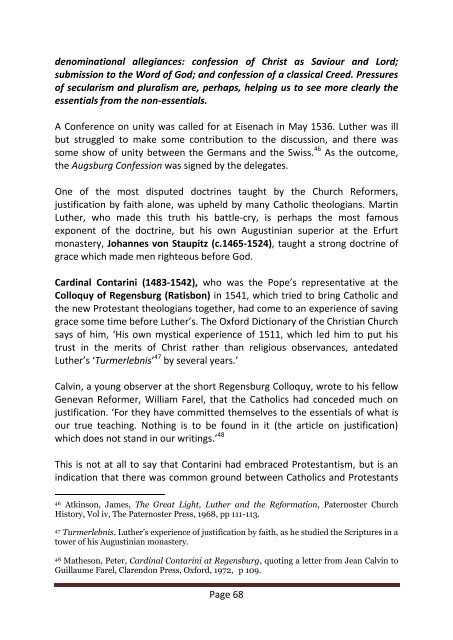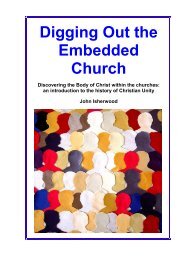Christian Unity (the book) - The Maranatha Community
Christian Unity (the book) - The Maranatha Community
Christian Unity (the book) - The Maranatha Community
Create successful ePaper yourself
Turn your PDF publications into a flip-book with our unique Google optimized e-Paper software.
denominational allegiances: confession of Christ as Saviour and Lord;submission to <strong>the</strong> Word of God; and confession of a classical Creed. Pressuresof secularism and pluralism are, perhaps, helping us to see more clearly <strong>the</strong>essentials from <strong>the</strong> non-essentials.A Conference on unity was called for at Eisenach in May 1536. Lu<strong>the</strong>r was illbut struggled to make some contribution to <strong>the</strong> discussion, and <strong>the</strong>re wassome show of unity between <strong>the</strong> Germans and <strong>the</strong> Swiss. 46 As <strong>the</strong> outcome,<strong>the</strong> Augsburg Confession was signed by <strong>the</strong> delegates.One of <strong>the</strong> most disputed doctrines taught by <strong>the</strong> Church Reformers,justification by faith alone, was upheld by many Catholic <strong>the</strong>ologians. MartinLu<strong>the</strong>r, who made this truth his battle-cry, is perhaps <strong>the</strong> most famousexponent of <strong>the</strong> doctrine, but his own Augustinian superior at <strong>the</strong> Erfurtmonastery, Johannes von Staupitz (c.1465-1524), taught a strong doctrine ofgrace which made men righteous before God.Cardinal Contarini (1483-1542), who was <strong>the</strong> Pope’s representative at <strong>the</strong>Colloquy of Regensburg (Ratisbon) in 1541, which tried to bring Catholic and<strong>the</strong> new Protestant <strong>the</strong>ologians toge<strong>the</strong>r, had come to an experience of savinggrace some time before Lu<strong>the</strong>r’s. <strong>The</strong> Oxford Dictionary of <strong>the</strong> <strong>Christian</strong> Churchsays of him, ‘His own mystical experience of 1511, which led him to put histrust in <strong>the</strong> merits of Christ ra<strong>the</strong>r than religious observances, antedatedLu<strong>the</strong>r’s ‘Turmerlebnis’ 47 by several years.’Calvin, a young observer at <strong>the</strong> short Regensburg Colloquy, wrote to his fellowGenevan Reformer, William Farel, that <strong>the</strong> Catholics had conceded much onjustification. ‘For <strong>the</strong>y have committed <strong>the</strong>mselves to <strong>the</strong> essentials of what isour true teaching. Nothing is to be found in it (<strong>the</strong> article on justification)which does not stand in our writings.’ 48This is not at all to say that Contarini had embraced Protestantism, but is anindication that <strong>the</strong>re was common ground between Catholics and Protestants46Atkinson, James, <strong>The</strong> Great Light, Lu<strong>the</strong>r and <strong>the</strong> Reformation, Paternoster ChurchHistory, Vol iv, <strong>The</strong> Paternoster Press, 1968, pp 111-113.47Turmerlebnis. Lu<strong>the</strong>r’s experience of justification by faith, as he studied <strong>the</strong> Scriptures in atower of his Augustinian monastery.48Ma<strong>the</strong>son, Peter, Cardinal Contarini at Regensburg, quoting a letter from Jean Calvin toGuillaume Farel, Clarendon Press, Oxford, 1972, p 109.Page 68








